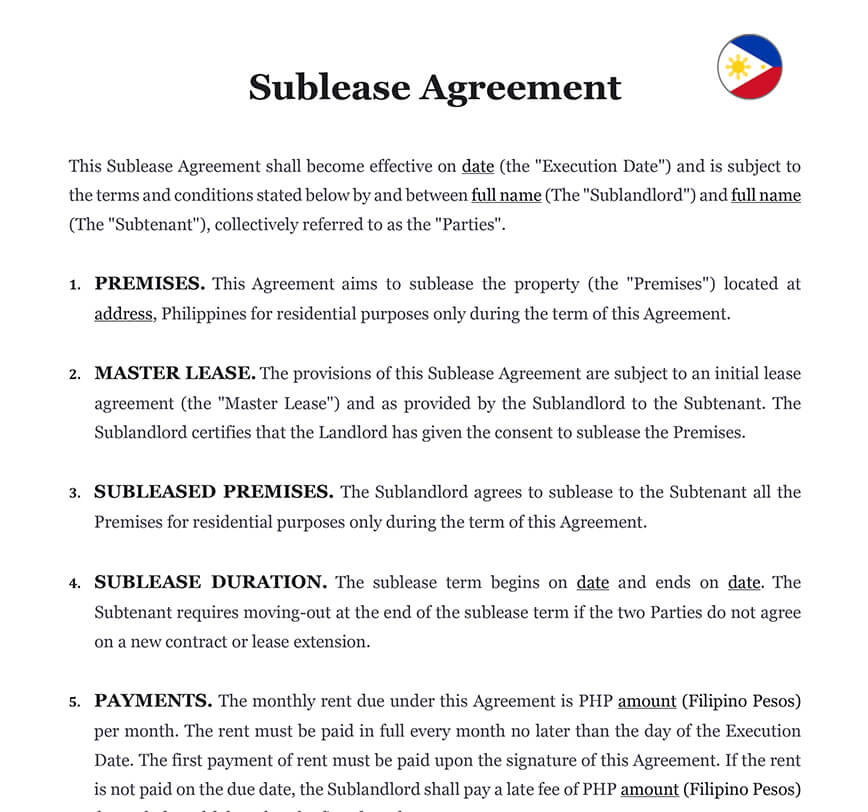Why to subletting a property in the Philippines?
Subletting a property in the Philippines can offer several advantages to tenants. Firstly, it provides an opportunity to offset rental costs by subletting a portion of the property to another tenant. This can be particularly beneficial for those facing financial constraints or looking for ways to maximize the utility of their rented space. Subletting also allows tenants to share living expenses, making it an attractive option for students, young professionals, or individuals looking for cost-effective accommodation. Additionally, subletting can help tenants maintain flexibility in their living arrangements. If a tenant needs to temporarily relocate or travel for an extended period, subletting allows them to retain their rental property while earning income from subtenants. However, it is essential to consider the legal and regulatory aspects of subletting and ensure compliance with the terms of the original lease agreement and relevant laws.
What are the key considerations for subletting a rented property in the Philippines?
Before subletting a rented property in the Philippines, there are several key considerations to keep in mind. Firstly, review the terms of your lease agreement. Some agreements may prohibit or require prior consent for subletting. It is crucial to understand any restrictions or obligations outlined in the lease to avoid breaching the contract. Additionally, assess the financial implications of subletting. Determine a fair and competitive rental rate for the sublet portion of the property to attract potential subtenants. Consider the costs associated with advertising, screening subtenants, and maintaining the property. Another important consideration is managing relationships and responsibilities. As the original tenant, you will act as the landlord to the subtenants. Ensure you have the time and capacity to handle tenant inquiries, address maintenance issues, and enforce lease agreements. Finally, it is essential to prioritize transparency and communication. Inform the property owner or landlord about your intention to sublet and seek their approval if required. Openly communicate with subtenants about the terms of the sublease and any rules or regulations they need to follow.
What are the legal requirements and regulations for subletting in the Philippines?
Subletting a rented property in the Philippines is subject to legal requirements and regulations to protect the rights of both tenants and landlords. The specific legal framework can vary, so it is crucial to consult the Civil Code of the Philippines, relevant local ordinances, and the terms of your lease agreement. Generally, subletting requires obtaining the consent of the property owner or landlord, as specified in the lease agreement. Failure to seek consent may result in breach of contract. Some leases may also require the subtenant to sign a separate sublease agreement directly with the original tenant. It is important to ensure that the terms of the sublease agreement align with the original lease agreement and comply with applicable laws. Additionally, subtenants are entitled to similar rights and protections as the original tenant. This includes the right to occupy the property without interference, the right to habitable living conditions, and protection against unlawful eviction. As the original tenant, you are responsible for upholding these rights and fulfilling your obligations as a landlord to the subtenants.
What is the step-by-step process of subletting a property in the Philippines?
Subletting a property in the Philippines involves a systematic process to ensure a smooth and legally compliant transaction. Here is a step-by-step guide:
Step 1. Review your lease agreement
Review your lease agreement: Understand the terms and conditions of your lease agreement, including any restrictions or requirements related to subletting.
Step 2. Seek permission
If your lease agreement requires it, obtain written permission from the property owner or landlord to sublet the property.
Step 3. Determine the sublet terms
Decide on the rental rate, lease duration, and any other terms for the sublet portion of the property. Consider marketrates, local rental regulations, and the condition of the property when determining the terms.
Step 4. Advertise and find subtenants
Utilize various channels to advertise the availability of the sublet, such as online platforms, social media, or word-of-mouth referrals. Screen potential subtenants carefully, including conducting background checks and verifying their financial stability and references.
Step 5. Draft a sublease agreement
Prepare a sublease agreement that outlines the terms and conditions between you (as the original tenant) and the subtenant. Include important details such as the rental amount, lease duration, responsibilities, and any additional rules or regulations specific to the sublet.
Step 6. Obtain necessary signatures
Ensure that both you and the subtenant sign the sublease agreement. Keep a copy for your records and provide a copy to the subtenant.
Step 7. Communicate with the property owner or landlord
Keep open lines of communication with the property owner or landlord throughout the subletting process. Inform them of the subtenant’s details and maintain transparency to ensure compliance with the lease agreement and applicable laws.
Step 8. Fulfill landlord responsibilities
As the original tenant and sublandlord, fulfill your responsibilities as a landlord to the subtenant. This includes addressing maintenance issues, providing necessary repairs, and respecting the subtenant’s rights.
Step 9. Collect rent and manage finances
Establish a system for collecting rent from the subtenant and managing financial transactions associated with the sublet. Keep accurate records of rental payments and expenses related to the sublet.
Step 10. Regularly communicate with subtenants
Maintain regular communication with the subtenant to address any concerns, coordinate repairs, and ensure a positive living experience for both parties.
By following these steps, you can navigate the subletting process in the Philippines while maintaining compliance with legal requirements and fostering positive relationships with subtenants and the property owner or landlord.
How to find subtenants for your rental property in the Philippines?
Finding suitable subtenants for your rental property in the Philippines requires a strategic approach. Here are some effective ways to find subtenants:
1. Online platforms: Utilize popular online property rental platforms and websites specific to the Philippines. Advertise the availability of the sublet, providing comprehensive details about the property, location, rental terms, and contact information.
2. Social media: Leverage social media platforms such as Facebook groups, community pages, or real estate-focused groups to reach a wider audience. Post about the sublet opportunity and encourage sharing among interested individuals.
3. Word-of-mouth referrals: Inform friends, colleagues, and acquaintances about the sublet. They may know someone who is actively seeking rental accommodation and can refer potential subtenants to you.
4. Local classifieds: Explore traditional classified advertisement platforms, both online and offline, that cater to rental property listings. Place an advertisement describing the sublet and your contact details.
5. University or workplace bulletin boards: If the property is in proximity to universities or workplaces, consider posting flyers or advertisements on bulletin boards. Many students and employees actively search for accommodation through these channels.
6. Real estate agents: Engage the services of real estate agents or property management companies with expertise in subletting. They can assist in finding suitable subtenants through their networks and marketing channels.
7. Networking: Tap into your personal and professional networks to spread the word about the sublet. Inform colleagues, industry connections, and local community members who may know someone in need of rental accommodation.
8. Tenant screening platforms: Consider using tenant screening platforms that provide verified tenant profiles. These platforms can help streamline the screening process by providing background checks, credit history, and rental references of potential subtenants.
Remember to provide accurate and detailed information about thesublet, including the rental terms, property features, and any specific requirements or restrictions. Conduct thorough screening of potential subtenants by verifying their background, financial stability, and rental history. Maintain clear communication throughout the process, promptly responding to inquiries and scheduling property viewings. By utilizing a combination of these strategies, you can increase your chances of finding reliable and suitable subtenants for your rental property in the Philippines.
How to manage risks when subletting in the Philippines?
Subletting a property in the Philippines requires careful consideration of potential risks. To effectively manage these risks, it is important to understand the legal framework, screen subtenants thoroughly, set clear expectations, maintain open communication, conduct regular property inspections, consider insurance coverage, keep thorough records, and seek legal advice if necessary. By implementing these best practices, landlords can minimize risks and create a secure subletting experience in the Philippines.











